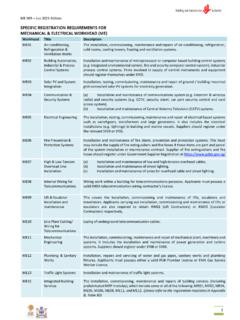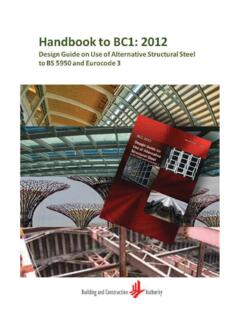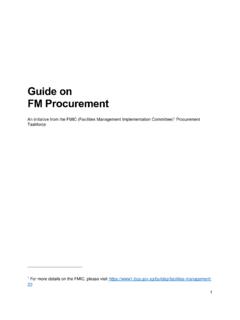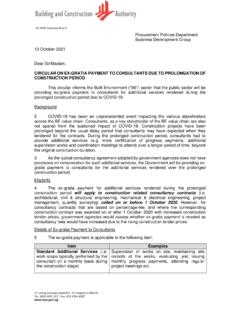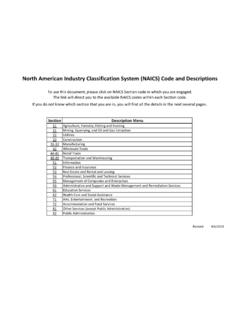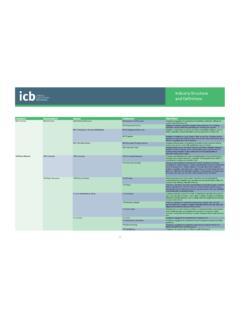Transcription of CODE OF PRACTICE ON Buildability
1 code OF PRACTICE ON Buildability 2017 Edition The code of PRACTICE on Buildability is electronically published by the Building and Construction Authority.
2 Building and Construction Authority, April 2017 All rights reserved. No part of this publication may be reproduced or transmitted in any form or by any means, without permission in writing from the publisher. Contents code OF PRACTICE Introduction 1 1 Scope 2 2 Definitions 2 3 Statutory Requirements 3 4 Categories of Buildings 4 5 Buildable Design Score Requirements 6 6 Submission Procedures for Buildable Design Score Requirements 12 7 Constructability Score Requirements 15 8 Submission Procedures for Constructability Score Requirements 18 9 Other Requirements 19 10 First Schedule 21 ANNEX A Buildable Design Appraisal System (BDAS)
3 22 B Constructability Appraisal System (CAS) 64 1 Introduction Since 2001, BCA had implemented the Buildability legislation for all building projects to raise productivity in the built environment sector and reduce its reliance on foreign workers. The mandatory requirements for adoption of buildable designs had also been progressively raised over the years. The legislation has had the effect of changing some of the design practices in the industry , for example, the switch to more flat plate designs, dry walls, precast construction and prefabrication, and adoption of higher repetition of grids, floor-to-floor heights and more repeated component sizes.
4 In 2011, BCA introduced the constructability requirements for builders to adopt more labour-efficient technologies and methods to improve productivity during construction. This helps to ensure that productivity concepts initiated during the upstream design phase by architects and engineers would be implemented with labour-saving construction processes by builders during the downstream construction phase. To accelerate the built environment sector s productivity improvement, especially in view of the more aggressive reductions in foreign worker supply, BCA raised the minimum standards for Buildable Design Score and Constructability Score further in 2013.
5 At the same time, the buildable design requirements were tightened to propel the industry towards adopting a greater degree of standardisation in building components and design parameters. Going forward, there is a need to lift productivity onto a higher plane by getting the industry to design and construct more buildable buildings and to exploit more labour-efficient technologies and productive methods of construction. Thus, in 2014 and 2015, besides further raising the minimum scores, BCA has mandated the adoption of key productivity components including industry -wide standard dimensions and building components for specific types of development.
6 In addition, specific productive technologies have also been stipulated as land sales conditions for developments sold under the Government Land Sales (GLS) Programme. This helps to pave the way for the industry to adopt the Design for Manufacturing and Assembly (DfMA) approach, by moving as much construction work off-site to a controlled manufacturing environment as possible and minimising work on site. While the industry has made good progress over the years, there is a need to build on the momentum and continue to strive for higher productivity improvement. As part of the larger drive towards wider adoption of prefabrication technologies along the DfMA continuum, the Buildability legislative framework has been enhanced further to raise construction productivity.
7 This code sets out the requirements of minimum Buildable Design Score, minimum Constructability Score and their submission procedures. It also sets out the method of determining the Buildable Design Score and the Constructability Score, as well as the requirements for the specific productive technologies stipulated for GLS sites which need to be fulfilled. Some amendments and revisions may be expected from time to time. If you need clarification on any aspect of this code of PRACTICE , please contact the Building and Construction Authority, Singapore. 2 1 SCOPE This code sets out the requirements of minimum Buildable Design Score and minimum Constructability Score for buildings, the method for determining the Buildable Design Score and the Constructability Score as well as their submission procedures.
8 It also sets out the requirements for the specific productive technologies which need to be complied with by developments built on Government Land Sales sites for which the technologies have been stipulated as land sales conditions. 2 DEFINITIONS For the purpose of this code , the following definitions shall apply: Buildability The extent to which the design of a building facilitates ease of construction as well as the extent to which the adoption of construction techniques and processes affects the productivity level of building works. Buildable Design Score The score for buildable design computed in accordance with the Buildable Design Appraisal System (BDAS) as set out in the code of PRACTICE .
9 Buildability Detailed Design and Implementation Plan Documents including plans which describe and define the type, extent of use and details of the building systems, building components, buildable features and Design for Manufacturing and Assembly (DfMA) technologies to be implemented for the building works for the purpose of computing the Buildable Design Score. Constructability Score The score for constructability computed in accordance with the Constructability Appraisal System (CAS) as set out in the code of PRACTICE . Constructability Implementation Plan Documents including plans which describe and define the type, extent of use and details of the construction techniques, processes, plant, equipment and innovative methods and systems to be implemented for the building works for the purpose of computing the Constructability Score.
10 Government Land Sales Programme A programme under which State land for private sector development is sold via public tender by the Government or a statutory board acting as an agent for the State. 3 Gross Floor Area The gross floor area is calculated using the definition by the Urban Redevelopment Authority (URA). Labour Saving Index (LSI) A value given to a particular building system which reflects the relative difference in site labour productivity associated with the various structural and wall systems. In certain instances, the LSI could be further lowered to discourage the use of labour intensive elements or components.

